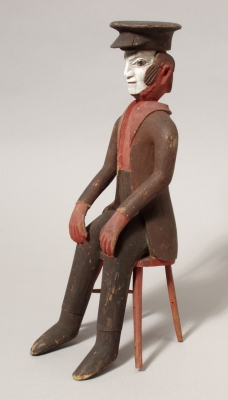Object biographies
This Object Biographies section of the Rethinking Pitt-Rivers website includes information about some of the artefacts in the founding collection at the Pitt Rivers Museum, University of Oxford and those which used to be in the Pitt-Rivers Museum at Farnham, Dorset, or in Pitt-Rivers' private residences in London and on his country estate, Rushmore. We hope that these varied articles will appeal to general readers as well as scholars.
The Pitt Rivers Museum Founding Collection
Information about artefacts belonging to the founding collection transferred to the Pitt Rivers Museum in Oxford in 1884
The Pitt-Rivers 'Second' Collection
Information about artefacts belonging Pitt-Rivers' second collection amassed after 1880.
Object Biographies and Rethinking Pitt-Rivers
Every thing has its history as every person has his own biography [Briggs, 1988: 27]
At the heart of the notion of biography are questions about the links between people and things: about the ways of meanings and values are accumulated and transformed. [Gosden and Marshall, 1999:172]
The biography of an object should not be restricted to an historical reconstruction of its birth, life and death. Biography is relational and an object biography is comprised of the sum of the relationships that constitute it. [Joy, 2009: 552]
All objects have a life (or series of different lives). All are made, bought and sold, used, treasured or discarded. Some then come into a museum where they can be involved in a number of different life-trajectories (stored, displayed, used in teaching etc). Pretty much every artefact in a museum has an interesting story of some kind that can be told about it and this part of the Rethinking Pitt-Rivers website aims to tell some of those stories for some of the objects associated with Augustus Henry Lane Fox Pitt-Rivers.
Gosden and Marshall suggest that the notion of object biography,
... goes back to Kopyoff (1986) who felt that things could not be fully understood at just one point in their existence and processes and cycles of production, exchange and consumption had to be looked at as a whole. Not only do objects change through their existence but they often have the capability of accumulating histories, so that the present significance of an object derives from the person or events to which it is connected. [1999: 170]
The idea of objects having (auto-)biography which can be recounted might be older than this suggests, and was certainly an idea current in Pitt-Rivers' own time and place, Victorian England. In 1870 Annie Carey, a science writer, published a volume entitled Autobiographies of a lump of coal, a grain of salt, a drop of water, a bit of old iron, a piece of flint (London), she followed this up with another book entitled Threads of Knowledge' whose subtitle Drawn from a Cambric; A Brussels Carpet; A Print Dress; A Kid Glove; and A Sheet of Paper shows the continuity of the theme. Both works were republished in 1880 as The Wonder of Common Things. Carey sought by providing autobiographies of things for children, to help them discover "the truth of things" as she wrote in her preface [quoted in Briggs, 1988: 297]. Another author, commenting on Carey's writing, suggests the idea might be even older:
When the children’s science writer Annie Carey published The Autobiography of a Lump of Coal in 1870, she was improvising on an old theme. The conceit of an inanimate object’s memoir is ancient; the seventh-century poem Dream of the Rood features a tree holding forth on just what it’s like to be cut down, carried out of the forest, and then pounded through with nails to crucify Jesus Christ.
See here for the full article from which this extract was taken.
The idea of including a section of a project website for articles about specific objects first began with the ESRC-funded Other Within project (2006-2009). The idea was so successful that it has been repeated for this project. Members of staff at the Pitt Rivers Museum at Oxford, students who study there and other researchers were invited to submit an article on any artefact of their choosing from the two collections of Pitt-Rivers. Apart from a little light editing by the project team the object biographies were added to the website as the original author intended. The variety and choice of artefacts is, therefore, fairly random, showing the tastes and interests of a wide variety of individuals associated with the museum at Oxford today. There was no set format to the articles but everyone was asked to identify the object by accession number (if they were in the Oxford collection), whether it was on display (ditto), and provide outline data from the museum's documentation before discussing the aspects of the object that appealled most to them. Contributors were also asked to consider what light their object biography threw on the Pitt-Rivers' collections as a whole.
Bibliography for this article
Briggs, Asa. 1988 Victorian Things London: Batsford
Gosden C. and Y. Marshall. 1999. 'The Cultural Biography of Objects' World Archaeology vol 31 no 2: 169-178.
Joy, Jody 2009.'Reinvigorating object biography: reproducing the drama of object lives', World Archaeology, 41: 4, 540-556
http://www.believermag.com/issues/200403/?read=article_collins



